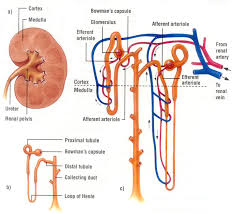So, today we took a vocab quiz, took notes, and yes, watched a porno. I'd say it was a productive class!
Here are the notes we took today...
Mammals have two kidneys and each is supplied with a renal artery and renal vein. Urine leaves the kidneys through the ureters, which drain into the urinary bladder. Urine is expelled from the body through the urethra.

Nephrons are made up of a single long tubules and the glomerules, a ball of capillaries. At the end of the tubule is the Bowman's capsule, a C-shaped capsule that surrounds the glomerulus.

The filtrate flows through the proximal tubule, the descending loop of Henle, the loop of Henle, the ascending loop of Henle, and the distal tubule. The distal tubule empties into a collecting duct, which recieves wastes from many nephrons. The filtrates empties into the renal pelvis
So that should catch anyone up on the notes they might have missed!
1. Which process in the nephron is least selective?
a. Filtration
b. Reabsorption
c. Active transport
d. Secretion
e. Salt pumping by the loop of the Henle
2. Urine formed by a kidney collects in the ____ before being drained from the kidney by the ____ and transported to the ______.
a. Urethra, urinary bladder, ureter
b. renal pelvis, medulla, cortex
c. renal pelvis, ureter, urinary bladder
d. renal pelvis, urethra, urinary bladder
e. ureter, renal pelvis, urinary bladder
3. The ____ are the major blood vessels transporting blood to the kidneys
a. pulmonary arteries
b. glomerulus
c. renal arteries
d. renal veins
e. venae cavae
4. The outer part of the kidney is the _____.
a. Medulla
b. Nephron
c. Lacteal
d. cortex
e. Bowman's capsule
5. Which of these is the functional unit of a kidney?
a. Neuron
b. Villi
c. Nephron
d. Alveolus
e. osteon
ANSWERS: A, C, C, D, C
Here is an FRQ on symbiotic relationships you can use as a refresher!
Organisms rarely exist alone in the natural environment. The following are five examples of symbiotic relationships.
Plant root nodules
Digestion of Cellulose
Epiphytic plants
AIDS
Anthrax
Choose FOUR and,
a) Identify the participants involved in the symbiosis and describe the symbiotic relationship
b) Discuss the specific benefit or detriment, if any, that each participant recieves from the relationship.
I thought this one was really hard and yes this was actually on an exam! Kinda scary... so starting to review now is a good idea!
Have a great night!
No comments:
Post a Comment